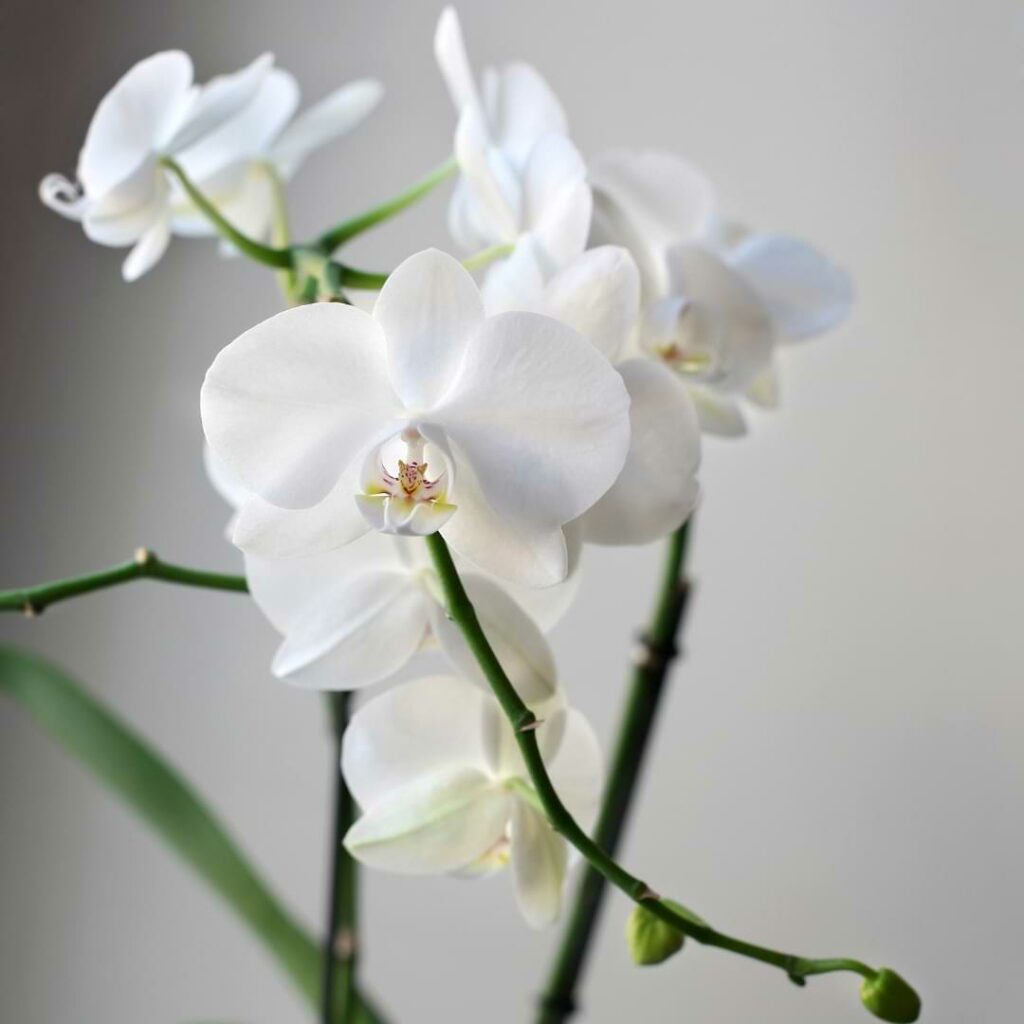Yes, plants can get sunburnt too! There’s nothing worse than bringing a beautiful flower into your home to brighten up the space, and then realize that your new orchid is getting sunburnt. Since orchids are native to tropical regions and are typically protected from direct sunlight by trees and shrubs, they do not do well in direct sunlight. Too much sun can damage the leaves, causing them to turn brown and dry out.
Keep reading to learn more about orchid sunburn, how to spot it and treat it so your beautiful flower can continue to thrive in your home.
Symptoms of Orchid Sunburn
Orchid sunburn can manifest in a few different ways, all of which are typically characterized by some level of discoloration or damage to the leaves of the plant. The flower can also become sunburnt, as well as the roots. Here are the symptoms to look out for with each type of sunburn.
Leaf Sunburn
If your orchid is getting too much sun, you may see the leaves start to curl up or turn yellow. Sunburned leaves will eventually turn brown and die. This is the most common form of sunburn on orchid plants, and the easiest one to spot and fix.
The most common symptom of sunburn on the orchid leaves is freckle-like specks of red or brown, and then those can turn into brown or black patches on the leaves, which may be dry and crispy to the touch. In more severe cases, the leaves may become yellowed or wilted, and may eventually drop off entirely.
Scorched Flowers
When orchids are exposed to too much sunlight, the leaves aren’t the only part of the plant that can get sunburned. The symptoms of scorched flowers include discoloration of the flower itself, and the flowers may drop off prematurely.
Sunburned orchids may also produce fewer flowers than usual, and the flowers that do bloom may be smaller than normal or have faded colors.
To prevent scorched flowers, make sure to provide your orchid with filtered light or indirect sunlight. If you notice any symptoms, move the plant to a shadier spot immediately and give it a thorough watering. If the leaves are badly damaged, you may need to trim them back to encourage new growth.
Sunburn on Orchid Roots
When orchids are grown in pots, they are often placed in an east- or north-facing window. While this provides the right amount of indirect sunlight, it can also cause sunburn on the roots if the pot is not properly protected. Symptoms of sunburn on orchid roots include yellowing leaves, wilting, and brown spots on the leaves. If you suspect your orchid has sunburn, move it to a shadier location and increase the humidity around the plant. You can also try misting the leaves with water to help cool them down. If the sunburn is severe, you may need to repot the plant in a pot with a lighter color.

How To Treat Sunburn On An Orchid
If you suspect your orchid has suffered from sunburn, it’s important to take action quickly to promote healing and prevent further damage. Start by moving the plant to a shadier spot, out of direct sunlight. If possible, place it in an east-facing window where it will still get some light but will be protected from the harsher afternoon sun.
Trim off the affected leaves, as long as it’s less than a third of the leaves on the whole plant. Be sure to use sharp scissors and cut at a 45-degree angle just above where the leaf meets the stem. If most of the leaves have suffered damage, try to wait it out without cutting any leaves off. You don’t want to send your plant into shock by removing too many leaves. Once you see new leaves growing, you can begin trimming off the sunburnt leaves.
Increase humidity in the area where your orchid is kept, and keep a close eye on your watering schedule for your orchid. Over the next few weeks it may need more watering than normal to rehydrate it. Avoid fertilizing during this crucial recovery period, because the plant will not be able to effectively use all of the nutrients in the fertilizer, and it may hinder recovery further.
Keep a really close eye on possible pests. An unhealthy plant is easier for a pest infestation to take advantage of, and that would only make for a longer recovery period for your plant. Don’t do any drastic pest control remedies, try natural remedies first if you do notice a pest problem. Chemical pest control may worsen your plant’s fragile condition.
Finally, give it some time – with proper care, your orchid should eventually bounce back from sunburn damage.
Can an Orchid Recover from Sunburn
An orchid can indeed recover from getting a sunburn, although it will take some special care and time to fully recover. Here’s a simplified step-by-step guide to help your orchid recover from sunburn, regardless of if the burn is on the leaves, the flower, or the roots.
- Move the plant somewhere with more shade or indirect light only.
- If less than one third of the leaves are affected, prune affected leaves. If more than a third, do not cut them off and just monitor closely.
- Water your plant well, do not fertilize.
- Increase humidity.
- Stay ahead of any possible pest infestation.
Removing Damaged Leaves
If your orchid’s leaves are severely damaged, you may need to remove them carefully with sterilized scissors. Once they’ve been removed, keep an eye on the remaining leaves for signs of new damage and take care to protect them from further sun exposure.
For leaves that only have specks of red or brown, it’s not recommended to remove them because they are still healthy enough to give the plant energy. Only remove the leaves that are significantly damaged. Refrain from removing more than a third of the leaves on the plant, as this can send your plant into shock, and that can be detrimental to the recovery process for your plant.
How To Avoid Orchid Sunburn
Orchids are incredibly sensitive to sunlight and can easily get sunburned if they are not protected from the sun, and it’s best for your plant to try to avoid sunburn altogether instead of attempting to treat it after the fact. Here are a few things you can do to avoid orchid sunburn:
-Keep your orchid out of direct sunlight. If you must put it in direct sunlight, make sure it is in a shady spot where it will not be directly exposed to the sun’s rays, or install some type of cover that will filter a majority of the direct sunlight.
-If you are growing your orchid outdoors, make sure it is in a spot that gets filtered sunlight. Direct sunlight is too strong for most outdoor orchids and will quickly cause them to sunburn. Under a large tree is usually a good spot, as long as it does not receive direct sunlight.
-Consider moving your plant around during the hottest part of the day, or during the summertime when the sun is even stronger. Map your house for the best indirect sunlight spots and consider keeping your orchid in those areas instead of areas with large windows that the sun shines through every day.
By following these simple tips, you can help prevent your orchid from getting sunburned
Sunburn On Orchids Final Thoughts
As with any plant, it is important to be aware of the risk of sunburn when growing orchids. While most orchids are tolerant of some sun exposure, they can still be susceptible to damage from too much sun.
If your orchid has been burned, it’s critical that you take the proper steps to help your plant recover. Simply moving it to a spot with less sunlight and giving it time to recover will do wonders for it. Don’t forget to prune back any severely damaged leaves, and watch for possible pest infestations while your plant is recovering.
If you have your heart set on having an orchid in a particularly sunny window, choose one of the varieties of orchids that are meant for more direct sun exposure. You can also use a sheer curtain to block most of the harmful sun rays, but still allow natural light into your home. Whatever you choose to do, your orchid will be happiest if you do what you can to prevent sunburn before it affects your beautiful houseplant.
Join Our Orchid Care Facebook Community
In our Facebook group of orchid lovers, we’re dedicated to creating a rich and engaging environment where plant lovers can come together and share tips, tricks, and experiences.
If you’re an orchid lover, come join our Facebook community! We can’t wait to celebrate your successes and help you troubleshoot your care routine.
For continued success, you can explore our other articles or visit our online shop for plant care products that are sure to keep your plants boasting rich green leaves and big, bountiful blooms year-round.



